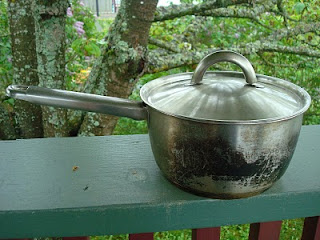The young, tender leaf-and-bud sets just before harvest.

The total 19 gram harvest.

First the leaves were withered indoors (at around 68° F) in the green stoneware bowl pictured above for 5.5 hours. Then a plate was put over the bowl, to act as a lid, as I shook the leaves very vigorously for 3 minutes. At this point the leaves were uncovered and allowed to oxidize in the bowl for about 16 hours. During this oxidation time, I occasionally mixed the leaves gently and sniffed their developing sweet aroma.
At 5:15 AM on April 27, 2010, I preheated my electric oven to 250° F and baked the bowl of leaves for 22 minutes (mixing once during the bake). After the bake, I transferred the leaves to a cool bowl, then, once the leaves had cooled down, I weighed them. The total yield of finished tea was 6.5 grams. Finally I put my newborn oolong tea into a little glass jar to wait until its debut later this week.
I am looking for a few tea friends to join me at Teacup on Saturday May 1st at 9:30 AM for a free tasting of my home-grown tea. All are welcome. Please contact me if you'll be able to come.
After 5.5 hours of withering and 6 hours of oxidation:
At 5:15 AM on April 27, 2010, I preheated my electric oven to 250° F and baked the bowl of leaves for 22 minutes (mixing once during the bake). After the bake, I transferred the leaves to a cool bowl, then, once the leaves had cooled down, I weighed them. The total yield of finished tea was 6.5 grams. Finally I put my newborn oolong tea into a little glass jar to wait until its debut later this week.
6.5 grams of finished tea:
I am looking for a few tea friends to join me at Teacup on Saturday May 1st at 9:30 AM for a free tasting of my home-grown tea. All are welcome. Please contact me if you'll be able to come.




































